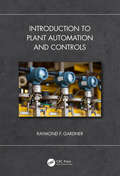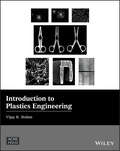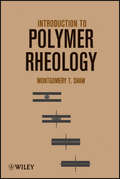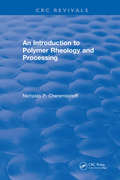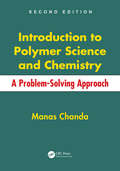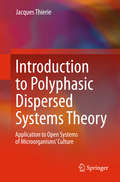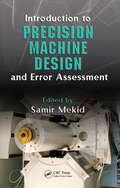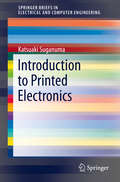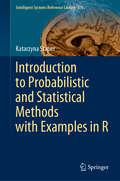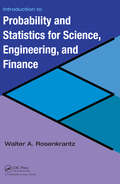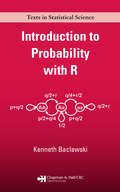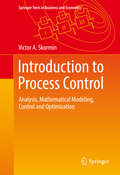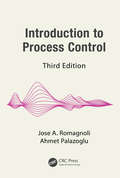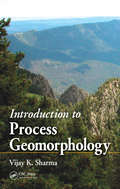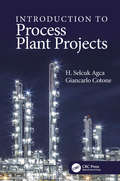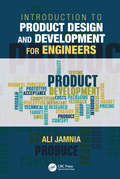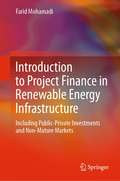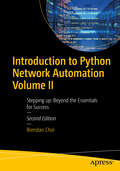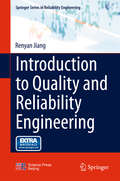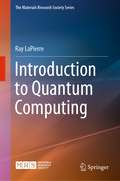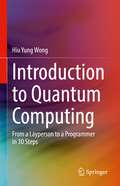- Table View
- List View
Introduction to Plant Automation and Controls
by Raymond F. GardnerIntroduction to Plant Automation and Controls addresses all aspects of modern central plant control systems, including instrumentation, control theory, plant systems, VFDs, PLCs, and supervisory systems. Design concepts and operational behavior of various plants are linked to their control philosophies in a manner that helps new or experienced engineers understand the process behind controls, installation, programming, and troubleshooting of automated systems. This groundbreaking book ties modern electronic-based automation and control systems to the special needs of plants and equipment. It applies practical plant operating experience, electronic-equipment design, and plant engineering to bring a unique approach to aspects of plant controls including security, programming languages, and digital theory. The multidimensional content, supported with 500 illustrations, ties together all aspects of plant controls into a single-source reference of otherwise difficult-to-find information. The increasing complexity of plant control systems requires engineers who can relate plant operations and behaviors to their control requirements. This book is ideal for readers with limited electrical and electronic experience, particularly those looking for a multidisciplinary approach for obtaining a practical understanding of control systems related to the best operating practices of large or small plants. It is an invaluable resource for becoming an expert in this field or as a single-source reference for plant control systems. Author Raymond F. Gardner is a professor of engineering at the U.S. Merchant Marine Academy at Kings Point, New York, and has been a practicing engineer for more than 40 years.
Introduction to Plant and Soil Science and Technology
by Jasper S. Lee Ronald J. BiondoAn introductory text for middle school and high school students, covering the role of plant and soil science, fundamentals of plant and soil science, plant pests, and meeting human needs with plants. Learning aids include career profiles and boxes on agri-industry connections, chapter summaries, questions, quizzes, and project ideas. Includes a glossary, and appendices.
Introduction to Plastics Engineering (Wiley-ASME Press Series)
by Vijay K. StokesThe authoritative introduction to all aspects of plastics engineering — offering both academic and industry perspectives in one complete volume. Introduction to Plastics Engineering provides a self-contained introduction to plastics engineering. A unique synergistic approach explores all aspects of material use — concepts, mechanics, materials, part design, part fabrication, and assembly — required for converting plastic materials, mainly in the form of small pellets, into useful products. Thermoplastics, thermosets, elastomers, and advanced composites, the four disparate application areas of polymers normally treated as separate subjects, are covered together. Divided into five parts — Concepts, Mechanics, Materials, Part Processing and Assembly, and Material Systems — this inclusive volume enables readers to gain a well-rounded, foundational knowledge of plastics engineering. Chapters cover topics including the structure of polymers, how concepts from polymer physics explain the macro behavior of plastics, evolving concepts for plastics use, simple mechanics principles and their role in plastics engineering, models for the behavior of solids and fluids, and the mechanisms underlying the stiffening of plastics by embedded fibers. Drawing from his over fifty years in both academia and industry, Author Vijay Stokes uses the synergy between fundamentals and applications to provide a more meaningful introduction to plastics. Examines every facet of plastics engineering from materials and fabrication methods to advanced composites Provides accurate, up-to-date information for students and engineers both new to plastics and highly experienced with them Offers a practical guide to large number of materials and their applications Addresses current issues for mechanical design, part performance, and part fabrication Introduction to Plastics Engineering is an ideal text for practicing engineers, researchers, and students in mechanical and plastics engineering and related industries.
Introduction to Polymer Rheology
by Montgomery T. ShawAn introduction to the rheology of polymers, with simple math Designed for practicing scientists and engineers interested in polymer rheology science, education, consulting, or research and development, Introduction to Polymer Rheology is a comprehensive yet accessible guide to the study of the deformation and flow of matter under applied stress. Often considered a complicated topic for beginners, the book makes grasping the fundamentals of polymer rheology easy by presenting information in an approachable way and limiting the use of complex mathematics. By doing so, this introductory overview provides readers with easy access to the key concepts underlying the flow behavior of polymer melts, solutions, and suspensions. Incorporating sample problems that are worked through and explained on the page, as well as numerous practice problems to gauge learning comprehension, the book prepares new students and practitioners for moving on to more advanced concepts. Comprising twelve chapters, the book covers stress, velocity and rate of deformation, the relationship between stress and rate of deformation (Newtonian fluid), generalized Newtonian fluids, normal stresses and elastic behavior, experimental methods, small and large strain, the molecular origins of rheological behavior, elementary polymer processing concepts, quality control in rheology, and the flow of modified polymers and those with supermolecular structure. The essential reference for accurately interpreting polymer rheology data, Introduction to Polymer Rheology provides readers with an elementary understanding of the key issues and modern approaches to resolving problems in the field. An Instructor's Guide with answers to select problems in the text, 60 new problems with full solutions, hints for effective presentation of the material in the text, and an errata listing is available for professors using the book as a course textbook.
Introduction to Polymer Rheology and Processing
by Nicholas P. CheremisinoffAn Introduction to Polymer Rheology and Processing is a practical desk reference providing an overview of operating principles, data interpretation, and qualitative explanation of the importance and relationship of rheology to polymer processing operations. It covers full-scale processing operations, relating industrial processing operations and design methodology to laboratory-scale testing. Hundreds of design formulas applicable to scaling up the processing behavior of polymeric melts are presented. The book also provides a "working knowledge" description of major rheological test methods useful in product development and includes a useful glossary of polymer and test method/instrumentation definitions. Lavishly illustrated and featuring numerous sample calculations and modeling approaches, An Introduction to Polymer Rheology and Processing is a "must have" book for polymer engineers and rheologists.
Introduction to Polymer Science and Chemistry: A Problem-Solving Approach, Second Edition
by Manas ChandaIndustry and academia remain fascinated with the diverse properties and applications of polymers. However, most introductory books on this enormous and important field do not stress practical problem solving or include recent advances, which are critical for the modern polymer scientist-to-be. Updating the popular first edition of "the polymer book for the new millennium," this volume seamlessly integrates exploration of the fundamentals of polymer science and polymer chemistry. It is peppered with helpful questions and answers throughout to enhance understanding of presented theories and concepts.
Introduction to Polymer Viscoelasticity
by Montgomery T. Shaw William J. MacKnightCompletely revised and updated, the fourth edition of this classic text continues to offer the reader a thorough understanding of viscoelastic behavior, essential for the proper utilization of polymers. Explains principles, corresponding equations, and experimental methods with supporting real-life applications Adds coverage of measurement techniques (nano-indentation, atomic force microscopy (AFM), and diffusing wave spectroscopy (DWS)), biopolymer viscoelasticity, and the relationship between mechanical polymer properties and viscoelastic functions Has two new ections to address modern areas of viscoelastic measurement: large amplitude oscillatory shear (LAOS) and microrheology Includes problems in the text and an Instructor’s Manual (including solutions) available for adopting professors Prior edition reviews: "The book is clear written and…[is] appropriate for students in introductory undergraduate courses and for others wanting introduction to the fundamentals of the subject." (CHOICE, December 2005); "This book is invariably well written, logically organized and easy to follow...I highly recommend this book to anyone studying polymer viscoelasticity." (Polymer News, December 2005)
Introduction to Polyphasic Dispersed Systems Theory
by Jacques ThierieThis book introduces a new paradigm in system description and modelling. The author shows the theoretical and practical successes of his approach, which involves replacing a traditional uniform description with a polyphasic description. This change of perspective reveals new fluxes that are cryptic in the classical description. Several case studies are given in this book, which is of interest of those working with biotechnology and green chemistry.
Introduction to Precision Machine Design and Error Assessment
by Samir MekidWhile ultra-precision machines are now achieving sub-nanometer accuracy, unique challenges continue to arise due to their tight specifications. Written to meet the growing needs of mechanical engineers and other professionals to understand these specialized design process issues, Introduction to Precision Machine Design and Error Assessment places
Introduction to Printed Electronics
by Katsuaki SuganumaThis book describes in detail modern technologies for printed electronics, explaining how nanotechnology and modern printing technology are merging to revolutionize electronics fabrication of thin, lightweight, large and inexpensive products. Readers will benefit from the explanations of materials, devices and circuits used to design and implement the latest applications of printed electronics, such as thin flexible OLED displays, organic solar cells, OLED lighting, smart wallpaper, sensors, logic, memory and more.
Introduction to Probabilistic and Statistical Methods with Examples in R (Intelligent Systems Reference Library #176)
by Katarzyna StaporThis book strikes a healthy balance between theory and applications, ensuring that it doesn’t offer a set of tools with no mathematical roots. It is intended as a comprehensive and largely self-contained introduction to probability and statistics for university students from various faculties, with accompanying implementations of some rudimentary statistical techniques in the language R. The content is divided into three basic parts: the first includes elements of probability theory, the second introduces readers to the basics of descriptive and inferential statistics (estimation, hypothesis testing), and the third presents the elements of correlation and linear regression analysis. Thanks to examples showing how to approach real-world problems using statistics, readers will acquire stronger analytical thinking skills, which are essential for analysts and data scientists alike.
Introduction to Probability and Statistics for Engineers
by Milan HolickýThe theory of probability and mathematical statistics is becoming an indispensable discipline in many branches of science and engineering. This is caused by increasing significance of various uncertainties affecting performance of complex technological systems. Fundamental concepts and procedures used in analysis of these systems are often based on the theory of probability and mathematical statistics. The book sets out fundamental principles of the probability theory, supplemented by theoretical models of random variables, evaluation of experimental data, sampling theory, distribution updating and tests of statistical hypotheses. Basic concepts of Bayesian approach to probability and two-dimensional random variables, are also covered. Examples of reliability analysis and risk assessment of technological systems are used throughout the book to illustrate basic theoretical concepts and their applications. The primary audience for the book includes undergraduate and graduate students of science and engineering, scientific workers and engineers and specialists in the field of reliability analysis and risk assessment. Except basic knowledge of undergraduate mathematics no special prerequisite is required.
Introduction to Probability and Statistics for Science, Engineering, and Finance
by Walter A. RosenkrantzIntegrating interesting and widely used concepts of financial engineering into traditional statistics courses, Introduction to Probability and Statistics for Science, Engineering, and Finance illustrates the role and scope of statistics and probability in various fields.The text first introduces the basics needed to understand and create
Introduction to Probability with R (Chapman & Hall/CRC Texts in Statistical Science)
by Kenneth BaclawskiBased on a popular course taught by the late Gian-Carlo Rota of MIT, with many new topics covered as well, Introduction to Probability with R presents R programs and animations to provide an intuitive yet rigorous understanding of how to model natural phenomena from a probabilistic point of view. Although the R programs are small in length, they ar
Introduction to Process Control
by Victor A. SkorminThis textbook is intended for an introductory graduate level on process control, taught in most engineering curricula. It focuses on the statistical techniques and methods of control and system optimization needed for the mathematical modeling, analysis, simulation, control and optimization of multivariable manufacturing processes. In four sections, it covers: Relevant mathematical methods, including random events, variables and processes, and their characteristics; estimation and confidence intervals; Bayes applications; correlation and regression analysis; statistical cluster analysis; and singular value decomposition for classification applications. Mathematical description of manufacturing processes, including static and dynamic models; model validation; confidence intervals for model parameters; principal component analysis; conventional and recursive least squares procedures; nonlinear least squares; and continuous-time, discrete-time, s-domain and Z-domain models. Control of manufacturing processes, including transfer function/transfer matrix models; state-variable models; methods of discrete-time classical control; state variable discrete-time control; state observers/estimators in control systems; methods of decoupling control; and methods of adaptive control. Methods and applications of system optimization, including unconstrained and constrained optimization; analytical and numerical optimization procedures; use of penalty functions; methods of linear programming; gradient methods; direct search methods; genetic optimization; methods and applications of dynamic programming; and applications to estimation, design, control, and planning. Each section of the book will include end-of-chapter exercises, and the book will be suitable for any systems, electrical, chemical, or industrial engineering program, as it focuses on the processes themselves, and not on the product being manufactured. Students will be able to obtain a mathematical model of any manufacturing process, to design a computer-based control system for a particular continuous manufacturing process, and be able to formulate an engineering problem in terms of optimization, as well as the ability to choose and apply the appropriate optimization technique.
Introduction to Process Control, Third Edition (Chemical Industries)
by Jose A. Romagnoli Ahmet PalazogluIntroduction to Process Control, Third Edition continues to provide a bridge between traditional and modern views of process control by blending conventional topics with a broader perspective of integrated process operation, control, and information systems. Updated and expanded throughout, this third edition addresses issues highly relevant to today’s teaching of process control: Discusses smart manufacturing, new data preprocessing techniques, and machine learning and artificial intelligence concepts that are part of current smart manufacturing decisions Includes extensive references to guide the reader to the resources needed to solve modeling, classification, and monitoring problems Introduces the link between process optimization and process control (optimizing control), including the effect of disturbances on the optimal plant operation, the concepts of steady-state and dynamic back-off as ways to quantify the economic benefits of control, and how to determine an optimal transition policy during a planned production change Incorporates an introduction to the modern architectures of industrial computer control systems with real case studies and applications to pilot-scale operations Analyzes the expanded role of process control in modern manufacturing, including model-centric technologies and integrated control systems Integrates data processing/reconciliation and intelligent monitoring in the overall control system architecture Drawing on the authors’ combined 60 years of teaching experiences, this classroom-tested text is designed for chemical engineering students but is also suitable for industrial practitioners who need to understand key concepts of process control and how to implement them. The text offers a comprehensive pedagogical approach to reinforce learning and presents a concept first followed by an example, allowing students to grasp theoretical concepts in a practical manner and uses the same problem in each chapter, culminating in a complete control design strategy. A vast number of exercises throughout ensure readers are supported in their learning and comprehension. Downloadable MATLAB® toolboxes for process control education as well as the main simulation examples from the book offer a user-friendly software environment for interactively studying the examples in the text. These can be downloaded from the publisher’s website. Solutions manual is available for qualifying professors from the publisher.
Introduction to Process Geomorphology
by Vijay K. SharmaIntroduction to Process Geomorphology provides an integrative approach to the process dynamics and the origin of landforms by the contemporary processes involved in their evolution. The author highlights the physical and chemical laws governing the activity of the earth-surface processes in specific environmental stress conditions, puts forward com
Introduction to Process Plant Projects
by H. Selcuk Agca Giancarlo CotoneThe book covers all stages of process plant projects from initiation to completion and handover by describing the roles and actions of all functions involved. It discusses engineering, procurement, construction, project management, contract administration, project control and HSE, with reference to international contracting and business practices.
Introduction to Product Design and Development for Engineers
by Dr. Ali JamniaIntroduction to Product Design and Development for Engineers provides guidelines and best practices for the design, development, and evaluation of engineered products. Created to serve fourth year undergraduate students in Engineering Design modules with a required project, the text covers the entire product design process and product life-cycle, from the initial concept to the design and development stages, and through to product testing, design documentation, manufacturability, marketing, and sustainability. Reflecting the author's long career as a design engineer, this text will also serve as a practical guide for students working on their capstone design projects.
Introduction to Project Finance in Renewable Energy Infrastructure: Including Public-Private Investments and Non-Mature Markets
by Farid MohamadiWhat is project finance? What makes project or structured finance so relevant for large renewable energy infrastructure? Which vocabulary do I need to know in order to speak the same language during meetings with lawyers, investors, bankers and engineers? These questions and many more are answered throughout this book, offering real world examples to bridge the gap between theory and practice. The book details the role of each stakeholder in the development of renewable energy projects, the interconnection between all the agreements, the financial process from fundraising to financial close, the processes of due diligence, risk analysis, project investment valuation and much more. It also provides with an introduction to Portfolio Management using renewable energy assets and an explanation of the role of Climate Finance in green energy investments. The commented glossary enables readers to unpick the jargon used in project finance for renewable energy, and the numerous creative figures and comprehensive tables aid with understanding. Offering a complete picture of the discipline, Introduction to Project Finance in Renewable Energy Infrastructure will be of value to professionals, engineers and academics alike interested in understanding the process and components of project finance in renewable energy infrastructures, in both private and public-private contexts.
Introduction to Project Management: A Source Book for Traditional PM Basics
by Davies A. IgberaeseThis book presents the fundamentals of project management in simple language and an easy-to-understand format. It is targeted principally at those who are learning or desiring to learn project management as well as those who are already taking project management as a course of study or as a profession. It covers all the basic aspects of project management including the core areas prescribed by the Project Management Institute (PMI) in the Project Management Body of Knowledge (PMBOK) sixth edition. Although the PMBOK Guide seventh edition has significantly shifted focus from a process based standard to a principle based standard, it does not invalidate nor replace the detailed knowledge base contained in the sixth edition, which substantially emphasizes project management processes and knowledge areas. This is particularly apt for the traditional approach to project delivery, which is predictive in nature and has the bulk of the planning done upfront. The sections of the book are arranged in order of Project Management Processes as they fall within the respective Project Management Knowledge Areas. Experienced project manager, Davies Igberaese, presents all the basic content of traditional project management in a straightforward practical sequence as a typical project manager would go about the processes of initiating, planning, executing, monitoring, and closing a project without losing sight of the iterative nature of project management. The inclusion of Project Management Templates gives students and other users of the book the confidence required to effectively understand the basics of managing a wide variety of projects across disciplines including construction, building, industrial engineering, petroleum engineering, software engineering, information technology, business administration, and event management. Introduction to Project Management: A Source Book for Traditional PM Basics can serve as a core textbook for academic courses in project management, for preparing for PMP and CAPM Certification exams, as an excellent resource for new project managers, as well as a handy reference book for project sponsors.
Introduction to Python Network Automation Volume II: Stepping up: Beyond the Essentials for Success
by Brendan ChoiContinue your Python network automation journey and delve deeper into advanced techniques and methodologies. Volume 2 of this comprehensive guide takes you beyond the essentials, equipping you with advanced skills and strategies crucial for success in network automation. Building upon the knowledge gained in Volume 1, you’ll set the stage for mastery in this dynamic field. You’ll start by establishing a robust lab environment for advanced automation projects tailored to your needs and use practical exercises to gain valuable insights into essential networking protocols. Then automate repetitive tasks with precision and efficiency by leveraging powerful Python libraries and tools. You’ll also see how to streamline IP address management and data center infrastructure management tasks with Python. Discover advanced techniques for network management and monitoring to optimize network performance and security. Explore the development of custom tools and applications for Cisco IOS upgrade tasks in complex network environments and put your skills to the test with real-world scenarios. All this is designed to solidify your expertise and confidence in network automation practices. Your network management capabilities will be enhanced with advanced tools, such as NetBox. Introduction to Python Network Automation Volume 2 - Stepping up provides a comprehensive roadmap to elevate your skills and excel in the dynamic field of network automation. Whether you're a seasoned professional or a newcomer to the field, this guide equips you with the tools and knowledge needed to thrive in today's network automation landscape. What You Will Learn Apply Python fundamentals and network automation strategies effectively. Utilize Python for streamlined network administration, boosting productivity. Consolidate Linux fundamentals and IP network services for enhanced network management. Practice implementing regular expressions in Python for network application development. Develop working Cisco IOS upgrading Python application in PoC environment. Explore Python's extensive applications in enterprise network automation for versatile solutions. Who This Book Is For IT engineers and developers, network managers and students, who would like to learn network automation using Python.
Introduction to Quality and Reliability Engineering
by Renyan JiangThis book presents the state-of-the-art in quality and reliability engineering from a product life-cycle standpoint. Topics in reliability include reliability models, life data analysis and modeling, design for reliability as well as accelerated life testing and reliability growth analysis, while topics in quality include design for quality, acceptance sampling and supplier selection, statistical process control, production tests such as environmental stress screening and burn-in, warranty and maintenance. The book provides comprehensive insights into two closely related subjects, and includes a wealth of examples and problems to enhance readers' comprehension and link theory and practice. All numerical examples can be easily solved using Microsoft Excel. The book is intended for senior undergraduate and postgraduate students in related engineering and management programs such as mechanical engineering, manufacturing engineering, industrial engineering and engineering management programs, as well as for researchers and engineers in the quality and reliability fields. Dr. Renyan Jiang is a professor at the Faculty of Automotive and Mechanical Engineering, Changsha University of Science and Technology, China.
Introduction to Quantum Computing (The Materials Research Society Series)
by Ray LaPierreThis book provides a self-contained undergraduate course on quantum computing based on classroom-tested lecture notes. It reviews the fundamentals of quantum mechanics from the double-slit experiment to entanglement, before progressing to the basics of qubits, quantum gates, quantum circuits, quantum key distribution, and some of the famous quantum algorithms. As well as covering quantum gates in depth, it also describes promising platforms for their physical implementation, along with error correction, and topological quantum computing. With quantum computing expanding rapidly in the private sector, understanding quantum computing has never been so important for graduates entering the workplace or PhD programs. Assuming minimal background knowledge, this book is highly accessible, with rigorous step-by-step explanations of the principles behind quantum computation, further reading, and end-of-chapter exercises, ensuring that undergraduate students in physics and engineering emerge well prepared for the future.
Introduction to Quantum Computing: From a Layperson to a Programmer in 30 Steps
by Hiu Yung WongThis textbook introduces quantum computing to readers who do not have much background in linear algebra. The author targets undergraduate and master students, as well as non-CS and non-EE students who are willing to spend about 60 -90 hours seriously learning quantum computing. Readers will be able to write their program to simulate quantum computing algorithms and run on real quantum computers on IBM-Q. Moreover, unlike the books that only give superficial, “hand-waving” explanations, this book uses exact formalism so readers can continue to pursue more advanced topics based on what they learn from this book.Encourages students to embrace uncertainty over the daily classical experience, when encountering quantum phenomena;Uses narrative to start each section with analogies that help students to grasp the critical concept quickly;Uses numerical substitutions, accompanied by Python programming and IBM-Q quantum computer programming, as examples in teaching all critical concepts.
